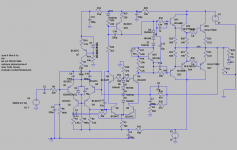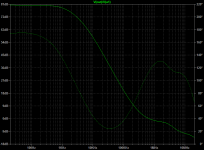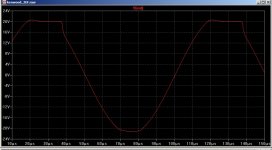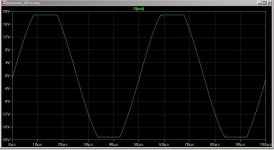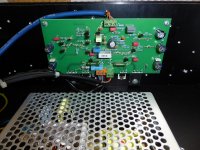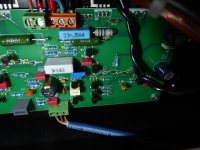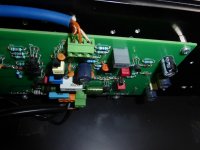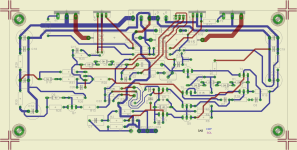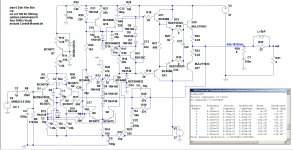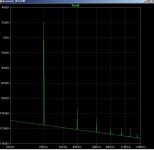Small class AB 50W/4ohm amplifier with SMPS (Gerber files added - see page 2) or linear supply
This amplifier is based on Kenwood KA-5010 circuit topology, class AB with 3EF output stage and 2-pole frequency compensation, which promises to keep low distortion even at higher frequencies. I was curious how it would work and built a 1st sample 5 years ago, followed by change of the linear power supply to SMPS's this year – resulting in a considerable loss of amplifier weight 😉.
Gerber files have been released in post #25 for non-commercial, non-profit personal use
https://www.diyaudio.com/community/...-4ohm-amplifier-with-smps.386169/post-7022262
This is the circuit schematics

As a power supplies I used Mean Well RS-100-24 modules, one per channel. This is the amplifier DIY built in one of my prototype cases
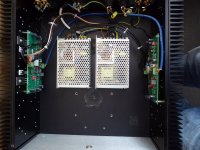
Technical parameters
Measurements of THD and THD+N vs. output power, with 4ohm load



Measurement of THD and THD+N vs. frequency at 20W/4ohm

Distortion spectrum

LTSpice files
P.S.: the amplifier has been re-measured with linear power supply 2x25Vm post #50, https://www.diyaudio.com/community/...-4ohm-amplifier-with-smps.386169/post-7031738
This amplifier is based on Kenwood KA-5010 circuit topology, class AB with 3EF output stage and 2-pole frequency compensation, which promises to keep low distortion even at higher frequencies. I was curious how it would work and built a 1st sample 5 years ago, followed by change of the linear power supply to SMPS's this year – resulting in a considerable loss of amplifier weight 😉.
Gerber files have been released in post #25 for non-commercial, non-profit personal use
https://www.diyaudio.com/community/...-4ohm-amplifier-with-smps.386169/post-7022262
This is the circuit schematics
As a power supplies I used Mean Well RS-100-24 modules, one per channel. This is the amplifier DIY built in one of my prototype cases

Technical parameters
- input impedance 90kohm
- voltage gain 30dB
- output noise voltage 22uV/20Hz-22kHz unweighted
- output power 2 x 50W/4ohm
- THD < 0.002%/40W/1kHz/4ohm
- THD < 0.003%/40W/10kHz/4ohm
- minimum load impedance 2.5ohm
- frequency response 10Hz – 100kHz/0.2dB/4ohm
Measurements of THD and THD+N vs. output power, with 4ohm load
Measurement of THD and THD+N vs. frequency at 20W/4ohm
Distortion spectrum
LTSpice files
P.S.: the amplifier has been re-measured with linear power supply 2x25Vm post #50, https://www.diyaudio.com/community/...-4ohm-amplifier-with-smps.386169/post-7031738
Attachments
Last edited:
The famous circuit is Hitachi Topology. For Negative Feedback I'm misleading why position C7 & R30. This is new to me
The circuit is basically taken from Kenwood KA-5010 service manual, with some modifications. C7 (in LTSpice scheme) is a FB DC blocking capacitor. (R30//R29)/R4 make a feedback divider. R30 with R29 prevent accumulation of DC charge across C7.The famous circuit is Hitachi Topology. For Negative Feedback I'm misleading why position C7 & R30. This is new to me
Hi, thank you, yes the clipping can be improved, if one cares about clipping.Hi, PMA. I propose revision to improve the clip.
I will try this modification to my other cascoded VAS. Decreased clipping behavior when using cascoded VAS vs other standard/advanced VAS. Thank you very much for the knowledgeHi, PMA. I propose revision to improve the clip.
So any specific steps you undertake to cope with the switching noise from the SMPS ?
Or the PSRR of the circuit is still excellent in the 60kHz region ?
Patrick
Or the PSRR of the circuit is still excellent in the 60kHz region ?
Patrick
Hello Pavel, any chance of this PCB being made available to purchase, or supplying the gerber files. Just what I am looking for - a good 50WPC class AB amp, using easily available parts.
All the noise is above 65kHz-70kHz, so I see no issues for audio, no audibility. Output audio noise voltage is 22uV/@22kHzBW, which is excellent and makes input noise of about 0.7uV/22kHz. In post #1 you can see the spectrum of 1kHz sine up to 45kHz, it is free of high order harmonics and elevated HF noise. 70kHz ripple noise is unimportant and it is not very high in level. With the SMPS you get rid of mains frequency (and multiples) induced forest of spectral lines resulting from radiated fields. As I am getting old, I also prefer not to carry 20 - 30 kg weight of amplifiers, I had to undergo 2 hernia surgery operations in past 10 years and do not need to go for the 3rd one 🙂. I changed much of my views of audio in the last years, lost of lot of audiophile prejudice.So any specific steps you undertake to cope with the switching noise from the SMPS ?
Or the PSRR of the circuit is still excellent in the 60kHz region ?
Patrick
Hello Pavel, any chance of this PCB being made available to purchase, or supplying the gerber files. Just what I am looking for - a good 50WPC class AB amp, using easily available parts.
We shall see, normally I do not give away the Gerber files and also stopped PCB sales 10 years ago. Let's see 🙂.
Interesting. At 20 W, 3rd and higher harmonics are really good but 2nd is not. Could this be an imbalance? The two diff pairs do not have current mirrors so their balance is at the mercy of part tolerances. Can you improve 2nd harmonic by making the Q11 current source adjustable?
What do the harmonics look like at 1 W or below? The THD vs. power plot imply an optimum at 0.1 W.
What do the harmonics look like at 1 W or below? The THD vs. power plot imply an optimum at 0.1 W.
At -92 dB it is probably good enough, maybe even pleasing (euphonic) but one should expect better with this kind of a circuit. Note how all the even orders are higher than the odd which points to an imbalance somewhere. Not that I'd want to have it the other way around, i.e. 3rd at -92 dB and even orders very low.
I'd rather have H3 -92dB and H2 -100dB, than H3 at the same -92dB but H2 at -70dB.
But that is my choice.
Patrick
But that is my choice.
Patrick
Nobody hears it, neither on music, nor on a single sine. This is again a prejudice. People are not able to tell percents of added 2nd harmonic in DBT tests, with music. Only on a sine with proper level, before the intrinsic ear distortion starts to work. I am always wondering how people were confused by the decades of audiophile brain washing.At -92 dB it is probably good enough, maybe even pleasing (euphonic)
Then why bother with "Small class A amplifier with THD below 0.0001%" ?
😉
Patrick
Just for fun, nothing else 🙂. Regarding audibility, there is no difference between these 2 amps and nobody would tell a difference in a properly matched DBT test. In a sighted test, everyone hears everything, better say just thinks so. Such is audio🙂.
Look, simulations are nice and helpful, but they tell just 10% of reality. Build a prototype, measure it and show the results. Almost anyone is doing simulations, not many build and measure real things.50 W AB(80mA) 4 ohm THD 20kHz -0.0002%
BTW, this amp here has also much lower distortion in simulation. Simulation is nothing but a first iterration. And, let’s talk about 4ohm loads. No real speaker has impedance and EPDR of 8 ohm and higher.
Last edited:
- Home
- Amplifiers
- Solid State
- SAB - class AB 2x50W/4ohm amplifier with SMPS
